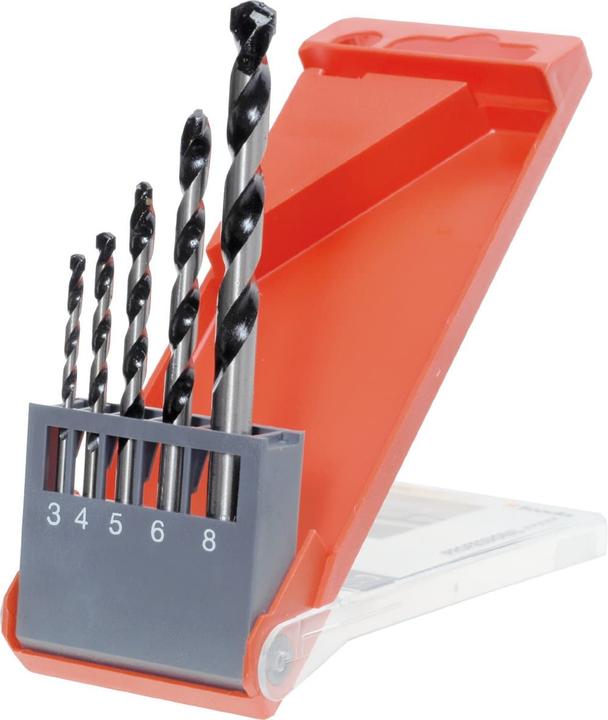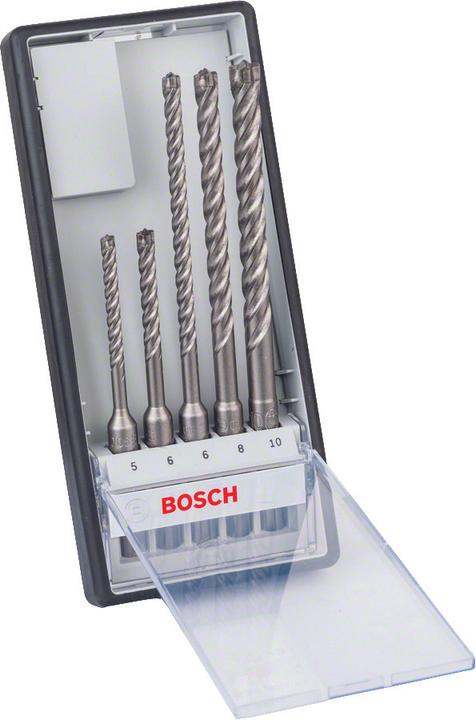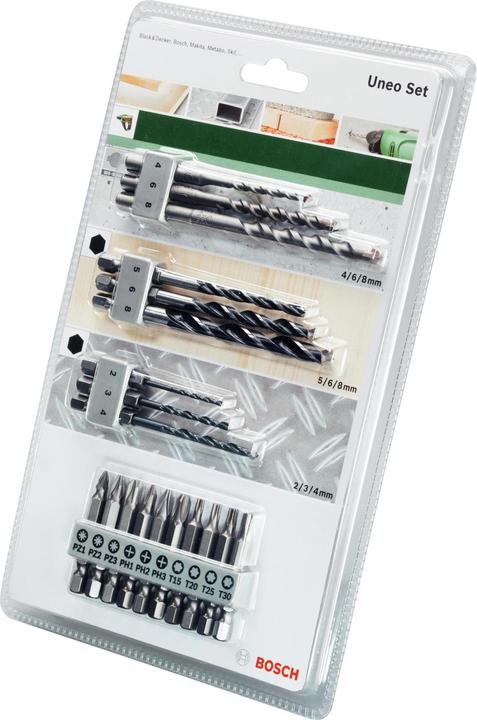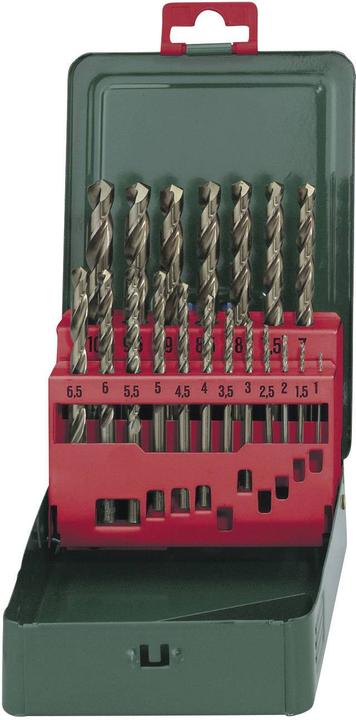
kwb Rocker concrete and masonry drill set 5 pcs.
3 mm, 4 mm, 5 mm, 6 mm, 8 mm

Wood, masonry, metal - the materials to be drilled are as varied as the drills themselves. It can therefore be difficult to find the right drill bit in practice.
I open the box of my drill, pictures need to be hung up. Inside the plastic case are plugs, screws and lots of drill bits. Shit, I'm not sure again which drill bit I need to use for my masonry. At first glance, they all look confusingly similar. By straining my brain cells, I finally find the right one. But I've already wasted several minutes before I even touch the drill.
But choosing the right tool is important. Have you ever tried drilling into concrete with a wood drill? You tear a small hole in the plaster and that's it. This is because the different drill bits have different properties that predestine them for a particular material.
The masonry drill bit must be able to drill into concrete, granite or masonry. These are all hard materials that require tough tools. This is why masonry drill bits are usually made of carbon or tool steel and have an additional carbide plate soldered into the tip. This plate is in the shape of a wedge or arrow, which smashes the material to be drilled with small blows. As you may have guessed, the masonry drill bit belongs in an impact drill or a hammer drill. The cutting edges are either blunt or ground. The first variant is suitable for concrete and masonry, the second is used without the percussion function and is intended for porous materials such as hollow bricks and tiles.
Short: The masonry drill bit has a wedge-shaped tip into which a carbide plate is incorporated.

kwb Rocker concrete and masonry drill set 5 pcs.
3 mm, 4 mm, 5 mm, 6 mm, 8 mm


Alpen Masonry drill
5 mm
The softie among the drill bits. It is also made of carbon or tool steel, but does not have a hard plate built in. A centring tip prevents the drill bit from shifting once it has been positioned. The cutting edges around the tip have a longer outer edge than the inner edge, which means that the edge of the drill hole is cut first. This results in clean, non-frayed drill holes. The wood drill bit can be used with any standard drill.
Short: You can recognise the wood drill bit by its centring tip and the comparatively wide cutting edges.


Bosch Professional Zubehör PRO Wood twist drill set. 7 pcs.
8 mm, 10 mm, 4 mm, 3 mm, 5 mm, 6 mm, 7 mm

This drill bit is made of high-speed steel (HSS), which can be used to drill holes in iron, steel, aluminium and plastic. The tip is conical and the surrounding cutting edges are quite sharp. If you are working with alloyed steel or stainless steel, the drill bit should also be coated with cobalt or titanium nitride. But even otherwise, the slightly higher purchase costs for the coating can be worthwhile, as this makes the drill bit more heat-resistant and lasts longer.
Short: The metal drill bit can be identified by its conical tip and two sharp cutting edges.

Bosch Zubehör Metal drill HSS-R, DIN 338 D= 1.0 mm L= 34 mm
1 mm

DeWalt HSS-G metal drill bit set
1 mm, 1.5 mm, 2 mm, 2.5 mm, 3 mm, 3.5 mm, 4 mm, 4.5 mm, 5 mm, 5.5 mm, 6 mm, 6.5 mm, 7 mm, 7.5 mm, 8 mm, 8.5 mm, 9 mm, 9.5 mm, 10 mm, 10.5 mm, 11 mm, 11.5 mm, 12 mm, 12.5 mm, 13 mm

Metabo Hss-Co
1 mm, 1.5 mm, 2 mm, 2.5 mm, 3 mm, 3.5 mm, 4 mm, 4.5 mm, 5 mm, 5.5 mm, 6 mm, 6.5 mm, 7 mm, 7.5 mm, 8 mm, 8.5 mm, 9 mm, 9.5 mm, 10 mm

Bosch Zubehör Metal drill HSS-R, DIN 338 D= 1.0 mm L= 34 mm
1 mm

DeWalt HSS-G metal drill bit set
1 mm, 1.5 mm, 2 mm, 2.5 mm, 3 mm, 3.5 mm, 4 mm, 4.5 mm, 5 mm, 5.5 mm, 6 mm, 6.5 mm, 7 mm, 7.5 mm, 8 mm, 8.5 mm, 9 mm, 9.5 mm, 10 mm, 10.5 mm, 11 mm, 11.5 mm, 12 mm, 12.5 mm, 13 mm

Metabo Hss-Co
1 mm, 1.5 mm, 2 mm, 2.5 mm, 3 mm, 3.5 mm, 4 mm, 4.5 mm, 5 mm, 5.5 mm, 6 mm, 6.5 mm, 7 mm, 7.5 mm, 8 mm, 8.5 mm, 9 mm, 9.5 mm, 10 mm
Sounds like an egg-laying woolly milk sow, but it would be too good to be true. The mixture of masonry, wood and metal drill bits is suitable for constructions in which different materials are used, such as in a reinforced concrete ceiling. If you perforate the materials individually, the universal drill bit is no alternative to the specialised drill bits. As the universal drill bit can handle all materials, it combines the features of the previous attachments. Like the masonry drill bit, it has a wedge-shaped tip with an integrated carbide plate, which is ground for employees working with wood. There are two sharp cutting edges around the outside of the tip, just like the metal drill bit.
Short: You can recognise the universal drill bit by the ground, wedge-shaped tip to which a carbide plate is soldered.
As you can see, all these drill bits differ in terms of material, tip and cutting edges, yet they all belong to the same family. The family of twist drills. There are many more attachments to describe, but they belong to other families. They are usually less common because they perform specialised tasks. For example, there is one for countersinking screws and another for drilling large holes. But that's for another time.
My life in a nutshell? On a quest to broaden my horizon. I love discovering and learning new skills and I see a chance to experience something new in everything – be it travelling, reading, cooking, movies or DIY.
Practical solutions for everyday problems with technology, household hacks and much more.
Show all